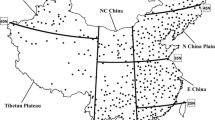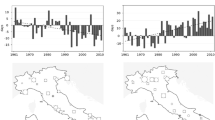Abstract
By comparing two sets of quality-controlled daily temperature observation data with and without the inhomogeneity test and adjustment from 654 stations in China during 1956–2004 and 1956–2010, impacts of inhomogeneity on changing trends of four percentile temperature extreme indices, including occurrences of cold days, cold nights, warm days, and warm nights with varying intensities, were discussed. It is found that the inhomogeneity affected the long-term trends averaged over extensive regions limitedly. In order to minimize the inhomogeneity impact, the 83 stations identified with obvious inhomogeneity impacts were removed, and an updated analysis of changing trends of the four temperature extreme indices with varying intensities during 1956–2010 was conducted. The results show that annual occurrences of both cold nights and cold days decreased greatly while those of warm nights and warm days increased significantly during the recent 20 years. The more extreme the event is, the greater the magnitude of changing trends for the temperature extreme index is. An obvious increasing trend was observed in annual occurrences of cold days and cold nights in the recent four years. The magnitude of changing trends of warm extreme indices was greater than that of cold extreme indices, and it was greater in northern China than in southern China. Trends for summer occurrence of cold days were not significant. Decreasing trends of occurrences of both cold nights and cold days were the greatest in December, January, and February (DJF) but the least in June, July, and August (JJA), while increasing trends of warm nights were the greatest in JJA. Cold nights significantly decreased from 1956 to 1990, and then the decreasing trend considerably weakened. The decreasing trend also showed an obvious slowdown in recent years for occurrence of cold days. However, increasing trends of warm nights and warm days both have been accelerated continuously since the recent decades. Further analysis presents that the evolution of the trends for occurrences of the four temperature extreme indices was dominated by the changes in northern China.
Similar content being viewed by others
References
Alexander, L. V., V. X. Zhang, T. C. Peterson, et al., 2006: Global observed changes in daily climate extremes of temperature and precipitation. J. Geophys. Res., 111, 22–31.
Bonsal, B. R., X. B. Zhang, L. A. Vincent, et al., 2001: Characteristics of daily and extreme temperature over Canada. J. Climate, 5 (14), 1959–1976.
Compiling Committee of China’s National Assessment Report on Climate Change, 2007: China’s National Assessment Report on Climate Change. Science Press, Beijing, 8–11. (in Chinese)
Cooter, E. J., and S. K. Leduk, 1993: Recent frost data trends in the northern United States. Int. J. Climatol., 15, 65–75.
Ding Yihui, Zhang Jin, Xu Ying, et al., 2003: Evolution and Prediction of Climate System. China Meteorological Press, Beijing, 4–6. (in Chinese)
Easterling, D. R., J. L. Evana, P. Y. Grosman, et al., 2000: Observed variability and trends in extreme climate events: A brief review. Bull. Amer. Meteor. Soc., 81, 417–425.
Goossens, C. H., and A. Berger, 1986: Annual and seasonal climatic variations over the Northern Hemisphere and Europe during the last centrury. Ann. Geophys., 4, 385–400.
Huang Danqing and Qian Yongfu, 2008: The definition of daily mean temperature extremes over China and its trend. Acta Scientiarum Naturalium Universitatis Sunyatseni, 47(3), 112–116. (in Chinese)
— and —, 2009: The analysis method of regional characteristics of extreme temperature and its results. Journal of Nanjing University (Natural Sciences), 45(6), 715–723. (in Chinese)
Jones, P. D., P. Y. Groisman, M. Coughlan, et al., 1990: Assessment of urbanization effects in time series of surface air temperature over land. Nature, 347, 169–172.
—, and M. Hulme, 1996: Calculating regional climatic time series for temperature and precipitation: Methods and illustrations. Int. J. Climatol., 16, 361–377.
—, D. H. Lister, and Q. Li, 2008: Urbanization effects in large-scale temperature records with an emphasis on China. J. Geophys. Res., 113, D16122, doi: 10.1029/2008JD009916.
Karl, T. R., G. Kukla, and J. Gavin, 1984: Decreasing diurnal temperature range in the Unite States and Canada from 1941–1980. J. Climate Appl. Meteor., 23, 1489–1504.
—, P. D. Jones, R. W. Knight, et al., 1993: A new perspective on recent global warming: Asymmetric trends of daily maximum and minimum temperature. Bull. Amer. Meteor. Soc., 74(6), 1007–1023.
Li Qingxiang, Liu Xiaoning, Zhang Zheng, et al., 2004: Detecting and adjusting the temporal inhomogeneity in Chinese mean surface air temperature dataset. Adv. Atmos. Sci., 21(4), 260–268. (in Chinese)
Liu Xiaoning and Li Qingxiang, 2003: Research of the inhomogeneity test of climatological data series in China. Acta Meteor. Sinica, 17(4), 492–502. (in Chinese)
Ma Zhuguo, Fu Congbin, Ren Xiaobo, et al., 2003: Trend of annual extreme temperature and its relationship to regional warming in northern China. Acta Geographica Sinica, 58, 11–20. (in Chinese)
Mann, H. B., 1945: Non-parametric test against trend. Econometrika, 13, 245–259.
Manton, M. J., P. M. Della-Marta, M. R. Haylock, et al., 2001: Trend in extreme daily rainfall and temperature in Southeast Asia and South Pacific: 1961-1998. Int. J. Climatol., 21, 269–284.
Pan Xiaohua and Zhai Panmao, 2002: Analysis of surface air temperature extreme. Meteor. Mon., 28, 28–31. (in Chinese)
Ren Fumin and Zhai Panmao, 1998: Study on changes of China’s extreme temperatures during 1951–1990. Scientia Atmospherica Sinica, 22(2), 217–227. (in Chinese)
Ren Guoyu, Zhou Yaqing, Chu Ziying, et al., 2008: Urbanization effects on observed surface air temperature trends in North China. J. Climate, 21, 1333–1348.
Solomon, S., D. Qin, M. Manning, et al., 2007: Climate Change 2007: The Physical Science Basis. Contribution of Working Group I to the Fourth Assessment Report of the Intergovernmental Panel on Climate Change. Cambridge University Press, Cambridge, 13.
Wei Fengying, 1999: Diagnosis and Forecasting Methods of Modern Climatic Statistics. China Meteorological Press, Beijing, 43–45. (in Chinese)
Wang Zunya, Ding Yihui, He Jinhai, et al., 2004: An updated analysis of the climate change in China in recent 50 years. Acta Meteor. Sinica, 62(2), 228–236. (in Chinese)
— and Ding Yihui, 2006: Climate change of the cold wave frequency of China in the last 53 years and the possible reasons. Chinese J. Atmos. Sci., 30(6), 1068–1076. (in Chinese)
Zhai Panmao and Pan Xiaohua, 2003a: Changes in extreme temperature and precipitation over northern China during the second half of the 20th century. Acta Geographica Sinica, 58, 1–10. (in Chinese)
— and —, 2003b: Trends in temperature extremes during 1951-1999 in China. Geophy. Res. Lett., 30(17), 1913, doi: 10.1029/2003GL018004.
Zhou Yaqing and Ren Guoyu, 2005: Identifying and correcting urban bias for regional surface air temperature series of North China over period of 1961–2000. Climatic Environ. Res., 10(4), 743–753. (in Chinese)
— and —, 2009: The effect of urbanization on maximum, minimum temperatures and daily temperature range in North China. Plateau Meteorology, 28(5), 1158–1166. (in Chinese)
— and —, 2010: Variation characteristics of extreme temperature indices in mainland China during 1956–2008. Climatic Environ. Res., 15(4), 405–417. (in Chinese)
Zhang Lei, Ren Guoyu, Liu Jiang, et al., 2011: Urban effect on trends of extreme temperature indices at Beijing meteorological station. Chinese J. Geophy., 54(5), 1150–1159. (in Chinese)
Author information
Authors and Affiliations
Corresponding author
Additional information
Supported by the National Natural Science Foundation of China (40905036).
Rights and permissions
About this article
Cite this article
Wang, Z., Ding, Y., Zhang, Q. et al. Changing trends of daily temperature extremes with different intensities in China. Acta Meteorol Sin 26, 399–409 (2012). https://doi.org/10.1007/s13351-012-0401-z
Received:
Accepted:
Published:
Issue Date:
DOI: https://doi.org/10.1007/s13351-012-0401-z




